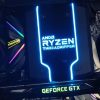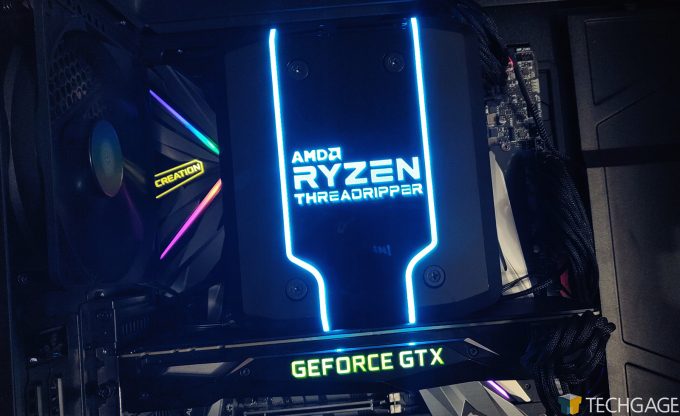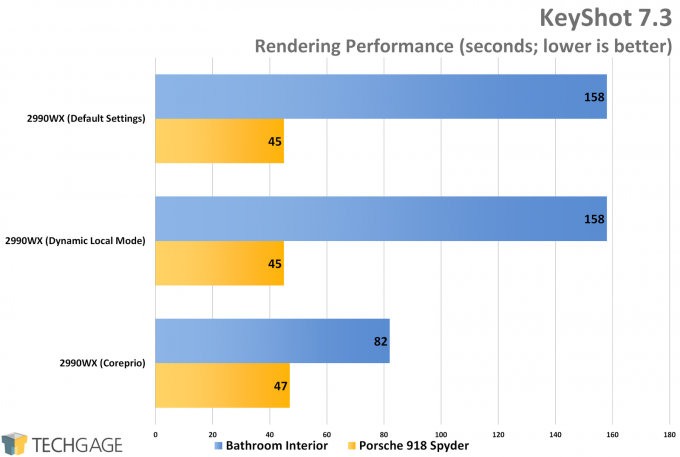- Qualcomm Launches Snapdragon 4 Gen 2 Mobile Platform
- AMD Launches Ryzen PRO 7000 Series Mobile & Desktop Platform
- Intel Launches Sleek Single-Slot Arc Pro A60 Workstation Graphics Card
- NVIDIA Announces Latest Ada Lovelace Additions: GeForce RTX 4060 Ti & RTX 4060
- Maxon Redshift With AMD Radeon GPU Rendering Support Now Available
AMD Ryzen Threadripper 2970WX & 2920X Workstation Performance

With its Ryzen Threadripper series, AMD wants you to “create with heavy metal”, but we all have different needs, and thus need different models to choose from. Having released both the 16- and 32-core Threadrippers last summer, the company recently followed-up with two more: 2920X, and 2970WX. Let’s put them to the test.
Page 7 – Final Thoughts
We’re reaching the end of our look at AMD’s 2920X and 2970WX, so it’s time to establish some conclusions. Fortunately, that’s fairly easily done. In most cases, the performance offered by both chips speaks volumes in our charts, but it still only tells half of the story. AMD continues to deliver its top chips with aggressive pricing, but that pricing isn’t going to be enough for everyone.
Where IPC and single-threaded performance is concerned, Intel continues to reign. On the flip-side, AMD reigns where cores-per-dollar are concerned, and if your workload takes proper advantage of the chips, big performance gains over the Intel competition can be seen.
If AMD’s Threadripper series had improved single-threaded performance, and managed to avoid caveats like the performance regressions that can be run against in some software, the products would become more attractive on a grand scale. Things are improving, and Zen 2 is shaping up to bring on much-needed improvements – so let’s hope it all plays out.
On the regression front, Microsoft will eventually release an update which will integrate kernel updates to better accommodate chips like the 2970WX and 2990WX. I am under the assumption that we won’t see this fix land in the next major Windows 10 update (~April), but will instead see it in the fall update. Given the core functionality of Windows that such an update would implement, it doesn’t seem likely that the fix would come to us as a regular Patch Tuesday update – but I’d love to be wrong.
It’s been mentioned a couple of times throughout this article that further regression testing is coming, thanks especially to the recent introduction of the Coreprio tool. With it, an alternative to AMD’s own Dynamic Local Mode became available, so if that solution doesn’t fix a regression, Coreprio may.
The below is a quick preview of what’s in store for this Coreprio article. KeyShot featured a notable regression in our testing, where one project rendered fine, but another ran worse on AMD’s top-core processor than another with half the number of cores. In the chart below, you can see the same projects run through default settings, with Dynamic Local Mode, and also Coreprio:
As with most images, this one doesn’t tell the full story, as there are occasions when Coreprio even gets it wrong. One run may encounter the regression, while most others won’t. Across extensive testing, we’ve found Coreprio to be successful 90% of the time, but your success rate may depend on the app or even the way you launch the application.
You can’t expect speed-ups like the above across all workloads that seem to have a regression, and in fact, this is the most extreme example we’ve come across. Another good example would be with Adobe’s Premiere Pro. There, one of our YouTube encodes finishes the job in 7m 50s, whereas with Coreprio, that drops to 4m 40s, but that improvement hasn’t proven to have a 100% success rate.
To beat a dead horse that’s about rotted at this point, with anything workstation-related, it really pays to know your workload. We occasionally see instances where a smaller chip can greatly outperform a bigger one, completely depending on the workload. If you use one of the tools featured in the article, the results will be able to show you what you can expect. If your software isn’t here, a web search will hopefully help you grasp what you can expect.
Overall, AMD’s Ryzen Threadripper processors are powerhouses that boast a better core-to-dollar ratio over the competition. However, that assumes that the solution you’re running with is able to take proper advantage of the chip. Some workloads may favor IPC over cores, as some of the results in this article have shown. Fortunately, if you use a CPU-bound renderer, Threadripper will serve you extremely well. KeyShot was the outlier of our rendering testing, and as covered above, Coreprio can help smooth that out.
In many cases throughout the article, AMD’s 12-core 2920X outperformed Intel’s Core i9-7900X, despite being priced at $350 less. That doesn’t mean that Intel’s solution isn’t worth considering, though, since it has faster single-threaded performance, and higher IPC in general, and still manages to dominate in some scenarios. Remember what we keep saying about “knowing your workload”? The 2970WX likewise outperformed the i9-7980XE often, but not all of the time, despite its huge core advantage.
If you’re still left with questions of whether or not these Threadrippers (or any other chips) are for you, feel free to leave a comment.
Support our efforts! With ad revenue at an all-time low for written websites, we're relying more than ever on reader support to help us continue putting so much effort into this type of content. You can support us by becoming a Patron, or by using our Amazon shopping affiliate links listed through our articles. Thanks for your support!







